 Facebook
Facebook
 X
X
 Instagram
Instagram
 TikTok
TikTok
 Youtube
Youtube
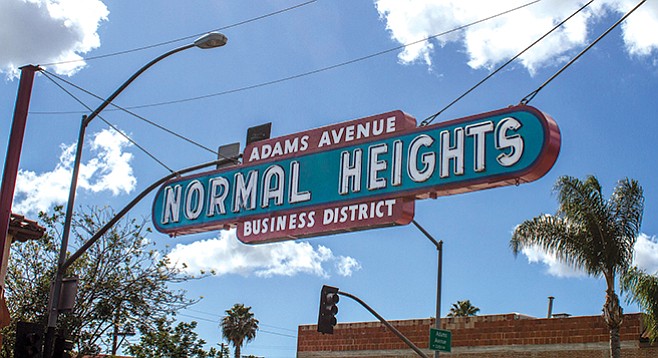
Adam Deutsch and his wife Claire moved to Normal Heights in 2014. Shortly after their move, the couple went to a meeting of the Normal Heights Community Planning Group to see what was going on in the neighborhood. That night they were two of four people in the audience listening to the group’s boardmembers holding forth on stage. One of the attendees, “blew up at a particular issue,” says Deutsch, who is 37, “and I enjoyed that intensity. So I started showing up regularly and, after a while, told the leaders that I would like to be on their board. It turned out they were trying to rotate the secretary position because nobody wanted to write up the minutes anymore. Since I had told them already that I teach English, they said I needed to be secretary.”

Despite initial hesitation, Deutsch — a poet, community-college teacher, and publisher of Cooper Dillon Books poetry press — began thinking that doing the meeting minutes of a neighborhood planning group might be rewarding. “I also write lots of poems, of course, and occasionally some scholarship in my academic field,” he tells me over coffee, “but this would be writing that becomes part of a public record. I think it’s important to make the minutes readable, and to be readable, they should be human.”
Here was Deutsch’s take on a family squabble over whether a new auto-repair shop should be allowed “off-alley” behind Smitty’s Service at the corner of Adams Avenue and Hawley Boulevard. In the November 7, 2017, planners meeting, a gentleman representing the potentially new garage owner launched into her family history. The speech, wrote Deutsch later in the minutes, was the “stuff of daytime melodrama, including characterization of a multitude of heroes, villains, deathbed signatures, mentions of a variety of unprovided paperwork, and one particular moment involving the brandishing of a pistol.”
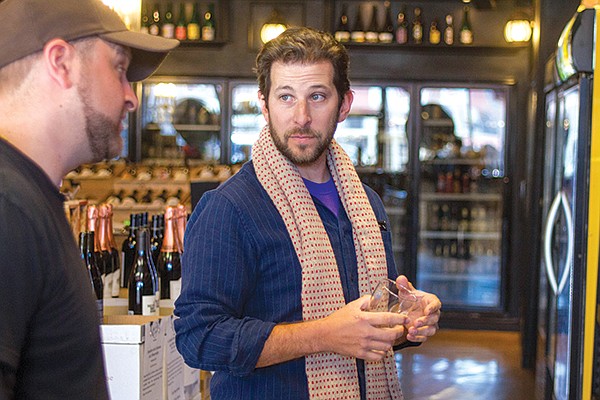
The lightheartedness of the description should not be taken as a lack of seriousness. Despite his short time in Normal Heights, Deutsch throws himself into the planning work. He engages the normal issues of mid-city planning, more park space, cracks in streets and sidewalks, the spread of homelessness, and a need for housing on El Cajon Boulevard. Additionally, prior to the debate over another auto shop behind Smitty’s, he spent four hours researching the Mid-Cities Community Plan and the City of San Diego Municipal Code. His “deep dives” into the relevant minutiae of legalities and guidelines helped his colleagues make an informed recommendation to vote against the garage. “I love doing the research,” he tells me with a wink.
Veteran community planner Gary Weber tells me, “I encourage as much as I can any newcomer to the board who is as committed as Adam. I’m getting too old to do much anymore.” But Weber still serves yet another term on the Normal Heights Community Planning Group. He founded it in 1991.
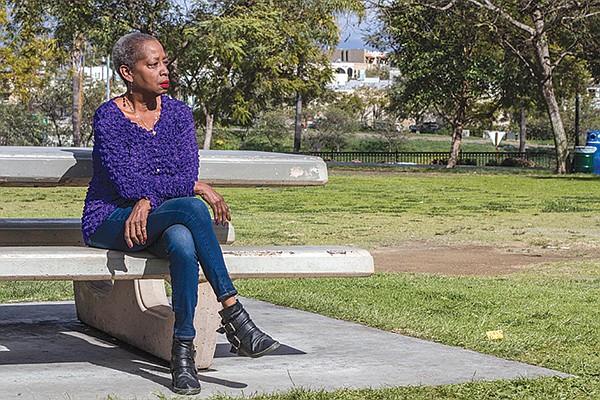
Of the neighborhoods that the San Diego Planning Department recognizes, Normal Heights is one of the smallest, contributing to its being highly walkable. Even a south/north hike from El Cajon Boulevard, the neighborhood’s southern boundary, to the rim of Mission Valley, its boundary on the north, is manageable at 30 to 45 minutes for most walkers. The community’s width, fixed by two freeways, I-15 on the east and I-805 on the west, is narrower. “On Adams Avenue, I can now walk easily from one edge of Normal Heights to the other,” says Joe Perry, who recently recovered from a workplace back injury. “And I always meet three or four friends along the way.”
For a different west/east route, the serpentine Mountain View Drive through the neighborhood north of Adams is preferable to some promenaders for its jacaranda, magnolia, Brazilian pepper, and many other trees through a neighborhood rich in architectural styles. Homes from pre–World War II intersperse with the most contemporary. Many participants in the yearly Rock ’n’ Roll Marathon say Mountain View Drive is the most pleasant segment of the run.
When Sylvia Thompson does her walking in Normal Heights, “There is always somebody to watch,” she says, “and that’s good for thinking about a character.” Thompson has worked in San Diego as a professional actor for 30 years. She moved to Normal Heights ten years ago.
After an Old Globe Theatre performance, the San Diego Theatre Critics Circle named Thompson its 2015 actor of the year. Thompson emails me that, on her 11th birthday, she was bitten by the theater bug when her mother took her to see The King and I.
Later, Thompson speaks with me in the Normal Heights Starbucks. She got her first local role at a dinner club in Spring Valley, where she performed in Agatha Christie’s Mousetrap. “Then I moved downtown to the Old Globe and the San Diego Repertory Theatre. There’s not one professional theater in San Diego I haven’t worked at. Theater’s been good to me here. No theater is making it on audiences, that’s for sure. But I’m a union actor receiving union wages.... But during the day I also teach kids in Coronado and National City.”
Stage fright is “one of the things I help them get rid of. I’ve never had that problem, not a single time. Not that I don’t get nervous when performing. But I love performing for live audiences and getting their feedback. It’s electric.”
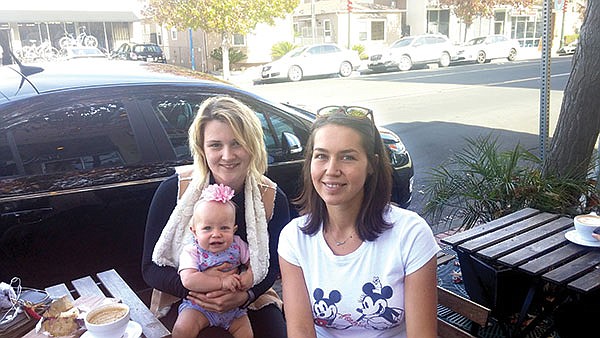
Two Russian-American young women who tend bar at Triple Crown Pub, a sports bar on Adams Avenue, also like walking the avenue. They sometimes each take a turn pushing a stroller and showing off a new baby girl. The child belongs to Ksusha Morgan, née Filipishina. To help me pronounce her first name, she tells me, “All letters are sounded in Russian.”
“Normal Heights feels like a very nonjudgmental place in many ways,” says Ksusha. “For example, in this neighborhood you can wear anything you like and people won’t care.”
It may sound trivial, but much of her sentiment derives from a comparison to the way it was in Russia, the country of her birth, in the late 1990s. Suddenly, as a nascent capitalist economy was taking hold, consumer goods were proliferating and a one-upmanship set into people’s habits of buying clothes, a reaction against attitudes in the former Soviet Union when everyone was expected to wear the same things. Ksusha knows about those “bad old days” largely through hearsay. She is 27 years old.
Ksusha’s close friend Anastasia (accent on the last i) Voroshilina, also 27, grew up in Saint Petersburg and studied for a while at the Saint Petersburg State University of Economics, where she and Ksusha first met. Ksusha had been a country girl, coming to the big city to study from her home in Siberia. Funny thing is, the girls say, a number of Triple Crown’s customers know about Siberia but have no idea where Saint Petersburg is.
How did two Russians end up tending bar at the same time in a Normal Heights tavern on Adams Avenue? The question contains a bit of suspicion, but “that often comes up,” says Anastasia, laughing. Part of the answer is that the two girls had been roommates in Chula Vista until Ksusha married. Then a mutual friend helped them get jobs at Triple Crown, but it is the open-minded character of Normal Heights that keeps them in the neighborhood, where they both now live.
In 2006, Normal Heights historian, and “sidewalk lady,” Suzanne Ledeboer uncovered a viewpoint complementary to that of the two Russian Americans’; it was expressed during a city-sponsored cultural retreat in January 2001. Some participants expressed complaints about Normal Heights, and some praise. “But others noted,” writes Ledeboer, “that, while largely underground, a thin vein of peaceful anarchy ran through some of its residents. Normal Heights was summed up best that day as ‘non-conformist.’”
The anecdote is found in Ledeboer’s January 12, 2006, article in the Journal of San Diego History, “San Diego’s Normal Heights: The Growth of a Suburban Neighborhood, 1886–1926.” During that time, according to Ledeboer, Normal Heights became one of San Diego’s “first ‘ring,’ or ‘streetcar,’ suburbs.” It picked up its name from the State Normal School built on Park Boulevard in 1899 along the trolley line coming north from downtown. Eventually, writes Ledeboer, “a shuttle trolley from Park Boulevard and Adams Avenue served Normal Heights in 1907, becoming a full-service line from downtown San Diego to Kensington at the end of the decade.”
Ledeboer’s article is a thorough and fascinating treatment of how real estate investors and developers, such as David Collier, George Hawley and others, built Normal Heights from open land into a community of largely blue-collar workers who, in 1925, would vote in favor of annexation to the City of San Diego.
The area south of Adams Avenue was the first to fill, foreshadowing the urban density that it still displays today. During the 1970s, the apartment complexes (often labeled “Huffman six packs,” after developer Ray Huffman) compounded the density with their helter-skelter replacement of Craftsman single-family homes. The more numerous incidents of crime that followed, the police department maintained, were due to the apartment buildings having no front windows.
Meanwhile, housing north of Adams developed slowly and became more valuable, especially the homes situated on the edge of Mission Valley. Eventually, “north of Adams,” and “south of Adams” reputations settled onto Normal Heights, creating in many residents’ minds a class divide.
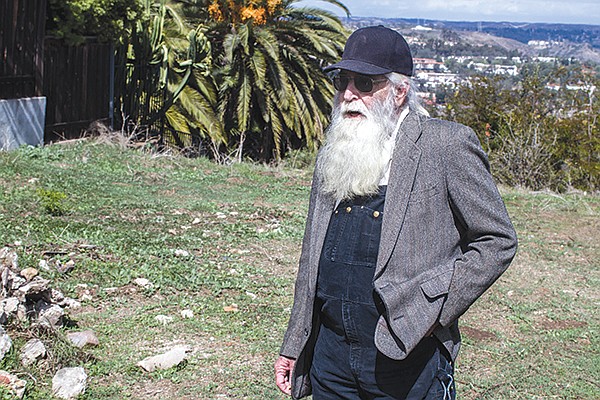
Of course, crime happens north of Adams, too. Whether the property invasion Jim Hopper experienced three years ago on the Eugene Place lot he owns qualifies as a crime, he did not bother asking the police. But he was thinking much like two lines of “Pretty Boy Floyd,” the Woody Guthrie Dust Bowl–era song: “Some will rob you with a six gun/ And some with a fountain pen.” While Guthrie meant banks that foreclosed farmers’ mortgages, Hopper thought surely his property had come under a siege of adverse possession.
“At the time,” says Hopper, “I was in arrears on my property taxes, although minimally. I think the perpetrator had looked into that and assumed I was an absentee owner, perhaps not even living in the state, since I get my mail in a PO box. He found this place he could put his junk on, an empty lot that overlooks the I-15 as it drops into Mission Valley. If I weren’t to pay attention for five years, he could state to the courts that he had his goods on the place long enough legally and his catching up on the property taxes would give him adverse possession.”
Hopper works as a carpenter on sets of local theater productions and is a member of the International Alliance of Theatrical Stage Employees Local 122. For years, he wrote reviews of science-fiction novels for the San Diego Union-Tribune until the paper curtailed its book reviews. He is a highly coveted participant in trivia contests at the Ould Sod bar on Adams.
“I first learned what was happening,” he tells me, “from a friend who called, saying, ‘There’s a guy here who says he bought your property.’ I rolled up there as quickly as I could and saw a ski boat in my yard behind the fence. There were many other things, too: a patio table, a crank-up umbrella, some teak deck furniture, a couple of tool sheds, and some valuable tools. I was more than a little annoyed.”
Neighbors Hopper had known there a while started giving him a variety of stories. “One said the guy told him he bought the property at auction for $10,” says Hopper. “Another said I sold it to him because I was broke and needed to liquidate. The fellow said he was my younger cousin and that I had allowed him to put his goods on my property. In all, I got five different stories from five different people.”
The next Monday, says Hopper, “I drove my motorcycle inside the fence, which is opaque, and sat down to wait in one of the guy’s chairs.” A crowbar and a machete from the tool shed were within his arm’s reach, “but it didn’t occur to me that this would be threatening because I was reading a book and drinking a beer. The fellow came in, his eyes got wide, and his jaw dropped. I introduced myself and said that I understood he was so-and-so with California driver’s license number such-and-such. (He had engraved his name and phone number on the tool box.) ‘You’ve got until Thursday to get the boat and the rest of this shit off my lot.’”
“‘Can I rent it from you?’
“‘No. You will find a place to take care of this. Thursday til sundown.’”
Hopper instructed the interloper not to contact him further but gave him a number to call if he had anything further to say.
“‘You’ve got this guy scared to death,’ an attorney friend told me after he was called. I don’t think of myself as a big scary guy but I guess I can be quite intimidating when I’m grumpy. Apparently, if you get into a place and last 30 days, it’s very difficult to get rid of you. That’s something my attorney also intimated.”
Many outsiders are likely to identify Normal Heights primarily as the neighborhood of the Adams Avenue Street Fair. “But even locals probably don’t realize that the Adams Avenue Business Association puts the street fair on,” says Scott Kessler, who is the organization’s executive director. The association is a business-improvement district serving Adams Avenue from Kensington, through Normal Heights, the northern part of North Park, and into University Heights as far as Arizona Street.
“The street fair had its beginnings in 1982,” Kessler tells me, “as a celebration of the refurbishment and relighting of the historic Normal Heights neon sign that hangs over Adams at Felton Street. It was also the initiation of a community revitalization effort. Local residents had seen the business corridor getting pretty blighted and they went to work to turn around the neighborhood, which had gone into decline for 20 years or more. It wasn’t anything peculiar to Normal Heights. The whole mid-city area was pretty marginal; capital had fled. It’s just a cycle that happens, just like downtown went through.
“Then, in 1985, the Normal Heights fire got people really organized, and that helped give rise to the formation of a few community groups, such as the Normal Heights Community Association.
“The Normal Heights sign is the only original neon sign I’m aware of that still hangs in San Diego. It’s in good shape. We just repainted it right before the street fair last year and we redid the neon. One of the business association’s duties is to maintain that sign. The structure is sound, and the cables are sound; it’s not going to fall. The sign had been hung up for the first time in the 1950s, although there is uncertainty about exactly when.”
Trained years ago as as a labor-union organizer, Kessler is now promoting small businesses. “Special events,” he says, “like the late-September street fair, Adams Avenue Unplugged (formerly the Roots Festival), and the Spirit Stroll have helped us market the area, to create economic opportunity and put money in people’s pockets. Over 300 vendors came to the 2017 street fair. One of the ways the street fair contributes to Normal Heights is to encourage entrepreneurs to come back and set up shop in the community.
“We used to do a lot of storefront rehab. The city has a program called the Storefront Improvement Program, a matching fund, and we had our own contracts with painters and electricians to go around and remodel the storefronts.

“Take the case of Mariposa Ice Cream. I think it cost Mariposa $4000 to put in tile and redo the transom windows. That was a lot of money when they moved in. More recently, I think the Rabbit Hole restaurant spent $750,000 opening their place.”
The Magaña-Ransoms, Richard and Anna, had been living in Mesa, Arizona, their strategic base for taking ice cream to street fairs throughout the Southwest, from New Mexico to California. “Before meeting my husband, I was working as a social-service caseworker assisting abusive families,” Anna tells me. “Ice cream turned out to be much happier work. I knew nothing about the business. But my husband had grown up on a dairy farm in Upstate New York, where he made ice cream as a youngster and learned all kinds of ice cream recipes.
The street fair in 1999 “sealed the deal for us,” Anna tells me. “I had lived here before, so I talked Richard into the move. Once the storefront was fixed up, we put in a dipping cabinet in front and a walk-in freezer in the back. We never had a storefront in Arizona.”
Richard Magaña-Ransom died in 2015. “I couldn’t even walk in here for the first six months after that,” says Anna. “He was the heart and soul of the business. He had a great sense of humor that made him the perfect front man for the business. I’m getting ready to retire now, although I have to say we’ve had such kind customers. My nephew, Tim Magaña, is buying the business. He’s gone to ice cream business seminars at the University of Wisconsin and has operated my sister’s business in Temecula.
“I used to say to my husband, ‘You’re the only white guy among seven business owners on this block [on the north side of Adams between Hawley and Mansfield]. There’s an Indian, Jordanian, Thai, Cambodian, and two Mexicans.”
“Normal Heights is now in an upswing,” says Scott Kessler a bit triumphantly.
It was not always so pleasant on Adams. By the middle of the 1980s, the avenue had descended into a haven for drug sales, gang hangouts, and prostitution. The hub of the deterioration was the intersection of Adams and Felton Street. It was at the same spot, however, where changes began that, over the past 30 years, have transformed the neighborhood into a prosperous and lively scene.
The turnaround started on July 23, 1986, with the opening of the Jyoti-Bihanga vegetarian restaurant on the southeast corner of the intersection. The establishment grew out of a relationship of Indian guru Sri Chinmoy with a group of his followers maintaining a meditation center in La Jolla during the 1980s. Chinmoy directed them to open a vegetarian restaurant in San Diego, and one of them, long known by now as Mahiyan, a name given him by the guru, led the group in looking for a suitable site.
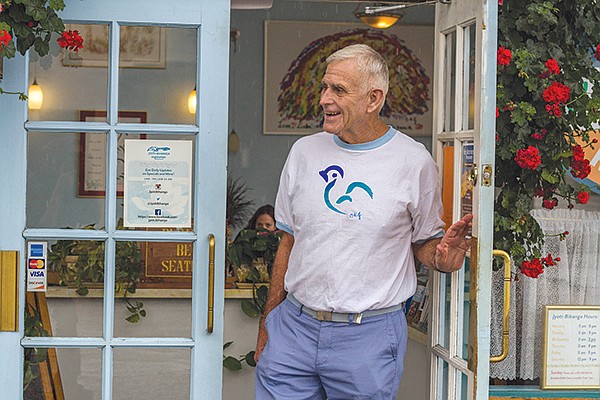
Mahiyan explains how Normal Heights became the restaurant’s home as he and I sit in its colorful dining room one morning an hour before opening. “We always had a lot of confidence in Sri Chinmoy’s insight and wisdom,” he says. “So we would send him pictures of possible sites, mainly in La Jolla, and he kept saying, ‘No, not there.’ Finally he said yes and then the landlord said, ‘No, I don’t want a restaurant here.’”
One day, a small contingent of the meditators went to buy advertising at the Holistic Living News, then situated across Adams and west a few doors. From there, they “just happened to see the for-rent sign on this building,” he says, “and it had been vacant for two years. It was a mess. It had a cracked cement floor, and the ceiling was orange and had silver flecks in it because, according to rumors, it had been a topless bar at one time. It was one long empty room, 75 feet down to the end. But at last we had stumbled onto a site.”
The lease was not affordable, but the landlord offered to drop its price by $500. “It was still too much,” says Mahiyan. So the group decided to wall off a section in the back to create an apartment that Mahiyan and others have used over the years. “We also decided we had to do the renovation ourselves. Besides all the paperwork, my assignment was the plumbing,” he adds, laughing.
The work seemed to take forever and, soon enough, there were money problems. “For a year,” says Mahiyan, “we had a sign on our door saying, ‘Opening Soon.’”
Mahiyan maxed out his credit cards and says they were finally taken away. “I was in such an anxious state that my meditations were having no effect,” he says. But after an especially ineffective one, he fell into a deep sleep. “Afterward I meditated again, and that meditation was my best ever. I don’t remember how, but the money we needed turned up after that.

“When the business opened, my sister was our first cook, and other restaurants in Sri Chinmoy’s [network] gave us recipes. We doubled our profits after two years and did well until after 2008, our busiest year. But then we started losing money at about 4 percent per year as a result of the big economic downturn, when restaurants of every kind started closing. But things slowly turned around.
“Sri Chinmoy came to San Diego occasionally and would sit in the back corner of the restaurant speaking with his students. Several times, Carlos Santana, one of his followers, joined him for long conversations.”
John Savage, Mahiyan’s birth name, owned a tennis shop in La Jolla at the time he met Sri Chinmoy. He had played varsity tennis at Fresno State and then at UCSD. “I once played in the French Open, but at a very low level,” he says. Sri Chinmoy was a great advocate of physical exercise, running marathons, and encouraging his followers to do it, too. Besides tennis, Mahiyan ran marathons for a number of years. “Running has similarities to meditation,” he says. “Think about runners’ high.”
For a long time, the Sri Chinmoy Center in back of Jyoti-Bihanga has offered free meditation classes. Mahiyan talks to me about meditation, not in a theoretical way, but rather emphasizing that it helps people “overcome personal limitations.”
In 1997, Lestat’s Coffee House made its appearance on Adams across Felton from Jyoti-Bihanga, when fledgling entrepreneur John Husler bought an existing café called Paradigm. He was successful quickly and, several years later, he took over the space next door, formerly the site of a game room. He called it Lestat’s West. The idea was to provide an all-ages music site connected to the coffee business.
Today Lestat’s West is arguably the most successful venue in San Diego for regular musical performances, comedy shows, poetry reading, and an open mic. Its manager is sound systems specialist Louis Brazier.
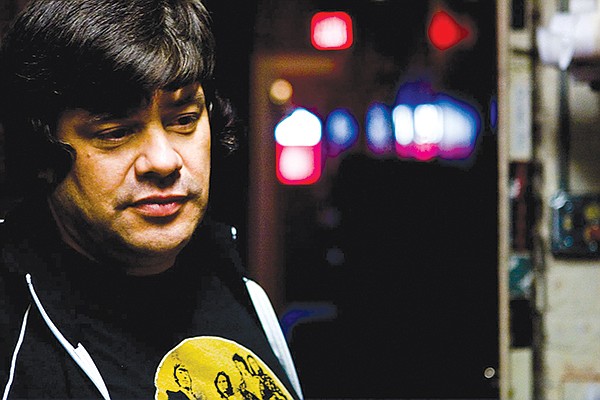
For seven years during the 1980s, Brazier worked for Solar Turbines. “I had a great job,” he tells me. “Full union, full medical, full dental, and was making $35 an hour. Then I quit at the factory in favor of a $6.50-an-hour job in a music-rehearsal hall.
“When my family learned what I did, they freaked out. My grandfather had worked for Solar Turbines for 45 years. I could have stayed there until retirement. I could have been married with a house and family. But I didn’t want to be the guy in the attic, years later, looking through my stuff and saying, ‘What if?’ And I had to find out if I could get to the level I craved in the music business.”
In 1999, Brazier, 55, got an opportunity to work in the Los Angeles market. He moved to North Hollywood and, for four years, toured the country with a number of musical groups, such as Richard Marx and the Cuban singer/actress Martiqua, and ending up with Ricky Nelson’s twins, Gunnar and Matthew. “I was the Nelsons’ personal assistant and Gunnar’s guitar tech,” Brazier tells me. “Gunnar had 16 guitars, and I would change strings, tune the guitars, and then, during the show, I’d be that guy who walks out and trades one guitar for another.
“I came to Lestat’s West in late 2003. Having grown up in Kensington, I had already done sound for a lot of the bands that played at the fabric store, when it was the Adams Avenue Theatre in the middle of our block, and was a music venue for a while.” (Today’s Discount Fabrics recently announced that it is liquidating and closing its doors.)
“When I asked myself what it would take to keep me here, I realized it was more about developing bands than anything else. I told John I would run the venue, but I wasn’t going to be a guy who puts eight bands on the bill just to fill the place, because it’s not about selling drinks. People come for quality music here, the good sound, and the owner has been behind me on that ever since. I still sometimes yearn for the life I could have had working at Solar, but here I have control. As long as I’m doing music, I’m happy.
“We have great artists here and quality sound. In some other places, it can be just loud. I found out earlier from showcasing big acts that the sound guy is just as much a member of the band as performers. If you don’t do your job, the music doesn’t come across.
“And there have been some great shows here that went late. I don’t want to go late every night. But sometimes there’s a good vibe when we’ve had big stars here, such as Minnie Driver, John C. Reilly, Greg Laswell, who’s from San Diego, and they’re spending the time to stay here with their fan base and talk. You want that. That’s what brings people back. They remember that.
“For instance, Tyler Hilton played here and stayed around afterward. He played Elvis in the Johnny Cash movie Walk the Line and then he was on One Tree Hill. That night felt like a real Hollywood moment. There were so many pictures being taken, and he was taking the time to sign everything. We didn’t get done until one or two o’clock.
“But the music business is changing so much. In earlier days, labels would sign bands and then develop them, get them out on the road, work on their songwriting craft or get them with a songwriter. Young artists today hardly have a chance. Of course, there’s YouTube, but nobody gets behind them, and it’s hard to tour on your own without that help.
“I tell the kids they have to promote themselves as much as possible, and what I want to do here is help bands make the money they need to do more. I’ve wanted to create a place that, later on, down the years, people will say this was where those artists developed great shows.”
Which artist does Brazier think has gotten the biggest career boost from performing at Lestat’s West? “Raelee Nikole,” he says without hesitation. “She’s 22 right now and coming on strong. She’s from East County and first came here when she was about 15.”
I have been thinking about how the work of the Normal Heights Community Planning Group relates to the many personal idiosyncrasies and expressions that play out in the neighborhood. In an email response, Adam Deutsch characterizes that work as concerned with “land use and implementing the community plan. The scope is less about guiding a cultural identity for the neighborhood and more about making sure the place as a whole is conducive to community and liveability, regardless of the demographics of who live in the neighborhood.”
“Isn’t it unusual,” I had asked Deutsch earlier, “for a poet and a scholar of literature, such as yourself, to get involved in public community work?”
He doesn’t think so, though he says nothing more about it. Instead, he gives me a poem he wrote called “Wife Says We Have Too Many Books.” It was published in the Winter 2016 edition of The Coachella Review. Here are several lines from the poem.


Adam Deutsch and his wife Claire moved to Normal Heights in 2014. Shortly after their move, the couple went to a meeting of the Normal Heights Community Planning Group to see what was going on in the neighborhood. That night they were two of four people in the audience listening to the group’s boardmembers holding forth on stage. One of the attendees, “blew up at a particular issue,” says Deutsch, who is 37, “and I enjoyed that intensity. So I started showing up regularly and, after a while, told the leaders that I would like to be on their board. It turned out they were trying to rotate the secretary position because nobody wanted to write up the minutes anymore. Since I had told them already that I teach English, they said I needed to be secretary.”

Despite initial hesitation, Deutsch — a poet, community-college teacher, and publisher of Cooper Dillon Books poetry press — began thinking that doing the meeting minutes of a neighborhood planning group might be rewarding. “I also write lots of poems, of course, and occasionally some scholarship in my academic field,” he tells me over coffee, “but this would be writing that becomes part of a public record. I think it’s important to make the minutes readable, and to be readable, they should be human.”
Here was Deutsch’s take on a family squabble over whether a new auto-repair shop should be allowed “off-alley” behind Smitty’s Service at the corner of Adams Avenue and Hawley Boulevard. In the November 7, 2017, planners meeting, a gentleman representing the potentially new garage owner launched into her family history. The speech, wrote Deutsch later in the minutes, was the “stuff of daytime melodrama, including characterization of a multitude of heroes, villains, deathbed signatures, mentions of a variety of unprovided paperwork, and one particular moment involving the brandishing of a pistol.”

The lightheartedness of the description should not be taken as a lack of seriousness. Despite his short time in Normal Heights, Deutsch throws himself into the planning work. He engages the normal issues of mid-city planning, more park space, cracks in streets and sidewalks, the spread of homelessness, and a need for housing on El Cajon Boulevard. Additionally, prior to the debate over another auto shop behind Smitty’s, he spent four hours researching the Mid-Cities Community Plan and the City of San Diego Municipal Code. His “deep dives” into the relevant minutiae of legalities and guidelines helped his colleagues make an informed recommendation to vote against the garage. “I love doing the research,” he tells me with a wink.
Veteran community planner Gary Weber tells me, “I encourage as much as I can any newcomer to the board who is as committed as Adam. I’m getting too old to do much anymore.” But Weber still serves yet another term on the Normal Heights Community Planning Group. He founded it in 1991.

Of the neighborhoods that the San Diego Planning Department recognizes, Normal Heights is one of the smallest, contributing to its being highly walkable. Even a south/north hike from El Cajon Boulevard, the neighborhood’s southern boundary, to the rim of Mission Valley, its boundary on the north, is manageable at 30 to 45 minutes for most walkers. The community’s width, fixed by two freeways, I-15 on the east and I-805 on the west, is narrower. “On Adams Avenue, I can now walk easily from one edge of Normal Heights to the other,” says Joe Perry, who recently recovered from a workplace back injury. “And I always meet three or four friends along the way.”
For a different west/east route, the serpentine Mountain View Drive through the neighborhood north of Adams is preferable to some promenaders for its jacaranda, magnolia, Brazilian pepper, and many other trees through a neighborhood rich in architectural styles. Homes from pre–World War II intersperse with the most contemporary. Many participants in the yearly Rock ’n’ Roll Marathon say Mountain View Drive is the most pleasant segment of the run.
When Sylvia Thompson does her walking in Normal Heights, “There is always somebody to watch,” she says, “and that’s good for thinking about a character.” Thompson has worked in San Diego as a professional actor for 30 years. She moved to Normal Heights ten years ago.
After an Old Globe Theatre performance, the San Diego Theatre Critics Circle named Thompson its 2015 actor of the year. Thompson emails me that, on her 11th birthday, she was bitten by the theater bug when her mother took her to see The King and I.
Later, Thompson speaks with me in the Normal Heights Starbucks. She got her first local role at a dinner club in Spring Valley, where she performed in Agatha Christie’s Mousetrap. “Then I moved downtown to the Old Globe and the San Diego Repertory Theatre. There’s not one professional theater in San Diego I haven’t worked at. Theater’s been good to me here. No theater is making it on audiences, that’s for sure. But I’m a union actor receiving union wages.... But during the day I also teach kids in Coronado and National City.”
Stage fright is “one of the things I help them get rid of. I’ve never had that problem, not a single time. Not that I don’t get nervous when performing. But I love performing for live audiences and getting their feedback. It’s electric.”

Two Russian-American young women who tend bar at Triple Crown Pub, a sports bar on Adams Avenue, also like walking the avenue. They sometimes each take a turn pushing a stroller and showing off a new baby girl. The child belongs to Ksusha Morgan, née Filipishina. To help me pronounce her first name, she tells me, “All letters are sounded in Russian.”
“Normal Heights feels like a very nonjudgmental place in many ways,” says Ksusha. “For example, in this neighborhood you can wear anything you like and people won’t care.”
It may sound trivial, but much of her sentiment derives from a comparison to the way it was in Russia, the country of her birth, in the late 1990s. Suddenly, as a nascent capitalist economy was taking hold, consumer goods were proliferating and a one-upmanship set into people’s habits of buying clothes, a reaction against attitudes in the former Soviet Union when everyone was expected to wear the same things. Ksusha knows about those “bad old days” largely through hearsay. She is 27 years old.
Ksusha’s close friend Anastasia (accent on the last i) Voroshilina, also 27, grew up in Saint Petersburg and studied for a while at the Saint Petersburg State University of Economics, where she and Ksusha first met. Ksusha had been a country girl, coming to the big city to study from her home in Siberia. Funny thing is, the girls say, a number of Triple Crown’s customers know about Siberia but have no idea where Saint Petersburg is.
How did two Russians end up tending bar at the same time in a Normal Heights tavern on Adams Avenue? The question contains a bit of suspicion, but “that often comes up,” says Anastasia, laughing. Part of the answer is that the two girls had been roommates in Chula Vista until Ksusha married. Then a mutual friend helped them get jobs at Triple Crown, but it is the open-minded character of Normal Heights that keeps them in the neighborhood, where they both now live.
In 2006, Normal Heights historian, and “sidewalk lady,” Suzanne Ledeboer uncovered a viewpoint complementary to that of the two Russian Americans’; it was expressed during a city-sponsored cultural retreat in January 2001. Some participants expressed complaints about Normal Heights, and some praise. “But others noted,” writes Ledeboer, “that, while largely underground, a thin vein of peaceful anarchy ran through some of its residents. Normal Heights was summed up best that day as ‘non-conformist.’”
The anecdote is found in Ledeboer’s January 12, 2006, article in the Journal of San Diego History, “San Diego’s Normal Heights: The Growth of a Suburban Neighborhood, 1886–1926.” During that time, according to Ledeboer, Normal Heights became one of San Diego’s “first ‘ring,’ or ‘streetcar,’ suburbs.” It picked up its name from the State Normal School built on Park Boulevard in 1899 along the trolley line coming north from downtown. Eventually, writes Ledeboer, “a shuttle trolley from Park Boulevard and Adams Avenue served Normal Heights in 1907, becoming a full-service line from downtown San Diego to Kensington at the end of the decade.”
Ledeboer’s article is a thorough and fascinating treatment of how real estate investors and developers, such as David Collier, George Hawley and others, built Normal Heights from open land into a community of largely blue-collar workers who, in 1925, would vote in favor of annexation to the City of San Diego.
The area south of Adams Avenue was the first to fill, foreshadowing the urban density that it still displays today. During the 1970s, the apartment complexes (often labeled “Huffman six packs,” after developer Ray Huffman) compounded the density with their helter-skelter replacement of Craftsman single-family homes. The more numerous incidents of crime that followed, the police department maintained, were due to the apartment buildings having no front windows.
Meanwhile, housing north of Adams developed slowly and became more valuable, especially the homes situated on the edge of Mission Valley. Eventually, “north of Adams,” and “south of Adams” reputations settled onto Normal Heights, creating in many residents’ minds a class divide.

Of course, crime happens north of Adams, too. Whether the property invasion Jim Hopper experienced three years ago on the Eugene Place lot he owns qualifies as a crime, he did not bother asking the police. But he was thinking much like two lines of “Pretty Boy Floyd,” the Woody Guthrie Dust Bowl–era song: “Some will rob you with a six gun/ And some with a fountain pen.” While Guthrie meant banks that foreclosed farmers’ mortgages, Hopper thought surely his property had come under a siege of adverse possession.
“At the time,” says Hopper, “I was in arrears on my property taxes, although minimally. I think the perpetrator had looked into that and assumed I was an absentee owner, perhaps not even living in the state, since I get my mail in a PO box. He found this place he could put his junk on, an empty lot that overlooks the I-15 as it drops into Mission Valley. If I weren’t to pay attention for five years, he could state to the courts that he had his goods on the place long enough legally and his catching up on the property taxes would give him adverse possession.”
Hopper works as a carpenter on sets of local theater productions and is a member of the International Alliance of Theatrical Stage Employees Local 122. For years, he wrote reviews of science-fiction novels for the San Diego Union-Tribune until the paper curtailed its book reviews. He is a highly coveted participant in trivia contests at the Ould Sod bar on Adams.
“I first learned what was happening,” he tells me, “from a friend who called, saying, ‘There’s a guy here who says he bought your property.’ I rolled up there as quickly as I could and saw a ski boat in my yard behind the fence. There were many other things, too: a patio table, a crank-up umbrella, some teak deck furniture, a couple of tool sheds, and some valuable tools. I was more than a little annoyed.”
Neighbors Hopper had known there a while started giving him a variety of stories. “One said the guy told him he bought the property at auction for $10,” says Hopper. “Another said I sold it to him because I was broke and needed to liquidate. The fellow said he was my younger cousin and that I had allowed him to put his goods on my property. In all, I got five different stories from five different people.”
The next Monday, says Hopper, “I drove my motorcycle inside the fence, which is opaque, and sat down to wait in one of the guy’s chairs.” A crowbar and a machete from the tool shed were within his arm’s reach, “but it didn’t occur to me that this would be threatening because I was reading a book and drinking a beer. The fellow came in, his eyes got wide, and his jaw dropped. I introduced myself and said that I understood he was so-and-so with California driver’s license number such-and-such. (He had engraved his name and phone number on the tool box.) ‘You’ve got until Thursday to get the boat and the rest of this shit off my lot.’”
“‘Can I rent it from you?’
“‘No. You will find a place to take care of this. Thursday til sundown.’”
Hopper instructed the interloper not to contact him further but gave him a number to call if he had anything further to say.
“‘You’ve got this guy scared to death,’ an attorney friend told me after he was called. I don’t think of myself as a big scary guy but I guess I can be quite intimidating when I’m grumpy. Apparently, if you get into a place and last 30 days, it’s very difficult to get rid of you. That’s something my attorney also intimated.”
Many outsiders are likely to identify Normal Heights primarily as the neighborhood of the Adams Avenue Street Fair. “But even locals probably don’t realize that the Adams Avenue Business Association puts the street fair on,” says Scott Kessler, who is the organization’s executive director. The association is a business-improvement district serving Adams Avenue from Kensington, through Normal Heights, the northern part of North Park, and into University Heights as far as Arizona Street.
“The street fair had its beginnings in 1982,” Kessler tells me, “as a celebration of the refurbishment and relighting of the historic Normal Heights neon sign that hangs over Adams at Felton Street. It was also the initiation of a community revitalization effort. Local residents had seen the business corridor getting pretty blighted and they went to work to turn around the neighborhood, which had gone into decline for 20 years or more. It wasn’t anything peculiar to Normal Heights. The whole mid-city area was pretty marginal; capital had fled. It’s just a cycle that happens, just like downtown went through.
“Then, in 1985, the Normal Heights fire got people really organized, and that helped give rise to the formation of a few community groups, such as the Normal Heights Community Association.
“The Normal Heights sign is the only original neon sign I’m aware of that still hangs in San Diego. It’s in good shape. We just repainted it right before the street fair last year and we redid the neon. One of the business association’s duties is to maintain that sign. The structure is sound, and the cables are sound; it’s not going to fall. The sign had been hung up for the first time in the 1950s, although there is uncertainty about exactly when.”
Trained years ago as as a labor-union organizer, Kessler is now promoting small businesses. “Special events,” he says, “like the late-September street fair, Adams Avenue Unplugged (formerly the Roots Festival), and the Spirit Stroll have helped us market the area, to create economic opportunity and put money in people’s pockets. Over 300 vendors came to the 2017 street fair. One of the ways the street fair contributes to Normal Heights is to encourage entrepreneurs to come back and set up shop in the community.
“We used to do a lot of storefront rehab. The city has a program called the Storefront Improvement Program, a matching fund, and we had our own contracts with painters and electricians to go around and remodel the storefronts.

“Take the case of Mariposa Ice Cream. I think it cost Mariposa $4000 to put in tile and redo the transom windows. That was a lot of money when they moved in. More recently, I think the Rabbit Hole restaurant spent $750,000 opening their place.”
The Magaña-Ransoms, Richard and Anna, had been living in Mesa, Arizona, their strategic base for taking ice cream to street fairs throughout the Southwest, from New Mexico to California. “Before meeting my husband, I was working as a social-service caseworker assisting abusive families,” Anna tells me. “Ice cream turned out to be much happier work. I knew nothing about the business. But my husband had grown up on a dairy farm in Upstate New York, where he made ice cream as a youngster and learned all kinds of ice cream recipes.
The street fair in 1999 “sealed the deal for us,” Anna tells me. “I had lived here before, so I talked Richard into the move. Once the storefront was fixed up, we put in a dipping cabinet in front and a walk-in freezer in the back. We never had a storefront in Arizona.”
Richard Magaña-Ransom died in 2015. “I couldn’t even walk in here for the first six months after that,” says Anna. “He was the heart and soul of the business. He had a great sense of humor that made him the perfect front man for the business. I’m getting ready to retire now, although I have to say we’ve had such kind customers. My nephew, Tim Magaña, is buying the business. He’s gone to ice cream business seminars at the University of Wisconsin and has operated my sister’s business in Temecula.
“I used to say to my husband, ‘You’re the only white guy among seven business owners on this block [on the north side of Adams between Hawley and Mansfield]. There’s an Indian, Jordanian, Thai, Cambodian, and two Mexicans.”
“Normal Heights is now in an upswing,” says Scott Kessler a bit triumphantly.
It was not always so pleasant on Adams. By the middle of the 1980s, the avenue had descended into a haven for drug sales, gang hangouts, and prostitution. The hub of the deterioration was the intersection of Adams and Felton Street. It was at the same spot, however, where changes began that, over the past 30 years, have transformed the neighborhood into a prosperous and lively scene.
The turnaround started on July 23, 1986, with the opening of the Jyoti-Bihanga vegetarian restaurant on the southeast corner of the intersection. The establishment grew out of a relationship of Indian guru Sri Chinmoy with a group of his followers maintaining a meditation center in La Jolla during the 1980s. Chinmoy directed them to open a vegetarian restaurant in San Diego, and one of them, long known by now as Mahiyan, a name given him by the guru, led the group in looking for a suitable site.

Mahiyan explains how Normal Heights became the restaurant’s home as he and I sit in its colorful dining room one morning an hour before opening. “We always had a lot of confidence in Sri Chinmoy’s insight and wisdom,” he says. “So we would send him pictures of possible sites, mainly in La Jolla, and he kept saying, ‘No, not there.’ Finally he said yes and then the landlord said, ‘No, I don’t want a restaurant here.’”
One day, a small contingent of the meditators went to buy advertising at the Holistic Living News, then situated across Adams and west a few doors. From there, they “just happened to see the for-rent sign on this building,” he says, “and it had been vacant for two years. It was a mess. It had a cracked cement floor, and the ceiling was orange and had silver flecks in it because, according to rumors, it had been a topless bar at one time. It was one long empty room, 75 feet down to the end. But at last we had stumbled onto a site.”
The lease was not affordable, but the landlord offered to drop its price by $500. “It was still too much,” says Mahiyan. So the group decided to wall off a section in the back to create an apartment that Mahiyan and others have used over the years. “We also decided we had to do the renovation ourselves. Besides all the paperwork, my assignment was the plumbing,” he adds, laughing.
The work seemed to take forever and, soon enough, there were money problems. “For a year,” says Mahiyan, “we had a sign on our door saying, ‘Opening Soon.’”
Mahiyan maxed out his credit cards and says they were finally taken away. “I was in such an anxious state that my meditations were having no effect,” he says. But after an especially ineffective one, he fell into a deep sleep. “Afterward I meditated again, and that meditation was my best ever. I don’t remember how, but the money we needed turned up after that.

“When the business opened, my sister was our first cook, and other restaurants in Sri Chinmoy’s [network] gave us recipes. We doubled our profits after two years and did well until after 2008, our busiest year. But then we started losing money at about 4 percent per year as a result of the big economic downturn, when restaurants of every kind started closing. But things slowly turned around.
“Sri Chinmoy came to San Diego occasionally and would sit in the back corner of the restaurant speaking with his students. Several times, Carlos Santana, one of his followers, joined him for long conversations.”
John Savage, Mahiyan’s birth name, owned a tennis shop in La Jolla at the time he met Sri Chinmoy. He had played varsity tennis at Fresno State and then at UCSD. “I once played in the French Open, but at a very low level,” he says. Sri Chinmoy was a great advocate of physical exercise, running marathons, and encouraging his followers to do it, too. Besides tennis, Mahiyan ran marathons for a number of years. “Running has similarities to meditation,” he says. “Think about runners’ high.”
For a long time, the Sri Chinmoy Center in back of Jyoti-Bihanga has offered free meditation classes. Mahiyan talks to me about meditation, not in a theoretical way, but rather emphasizing that it helps people “overcome personal limitations.”
In 1997, Lestat’s Coffee House made its appearance on Adams across Felton from Jyoti-Bihanga, when fledgling entrepreneur John Husler bought an existing café called Paradigm. He was successful quickly and, several years later, he took over the space next door, formerly the site of a game room. He called it Lestat’s West. The idea was to provide an all-ages music site connected to the coffee business.
Today Lestat’s West is arguably the most successful venue in San Diego for regular musical performances, comedy shows, poetry reading, and an open mic. Its manager is sound systems specialist Louis Brazier.

For seven years during the 1980s, Brazier worked for Solar Turbines. “I had a great job,” he tells me. “Full union, full medical, full dental, and was making $35 an hour. Then I quit at the factory in favor of a $6.50-an-hour job in a music-rehearsal hall.
“When my family learned what I did, they freaked out. My grandfather had worked for Solar Turbines for 45 years. I could have stayed there until retirement. I could have been married with a house and family. But I didn’t want to be the guy in the attic, years later, looking through my stuff and saying, ‘What if?’ And I had to find out if I could get to the level I craved in the music business.”
In 1999, Brazier, 55, got an opportunity to work in the Los Angeles market. He moved to North Hollywood and, for four years, toured the country with a number of musical groups, such as Richard Marx and the Cuban singer/actress Martiqua, and ending up with Ricky Nelson’s twins, Gunnar and Matthew. “I was the Nelsons’ personal assistant and Gunnar’s guitar tech,” Brazier tells me. “Gunnar had 16 guitars, and I would change strings, tune the guitars, and then, during the show, I’d be that guy who walks out and trades one guitar for another.
“I came to Lestat’s West in late 2003. Having grown up in Kensington, I had already done sound for a lot of the bands that played at the fabric store, when it was the Adams Avenue Theatre in the middle of our block, and was a music venue for a while.” (Today’s Discount Fabrics recently announced that it is liquidating and closing its doors.)
“When I asked myself what it would take to keep me here, I realized it was more about developing bands than anything else. I told John I would run the venue, but I wasn’t going to be a guy who puts eight bands on the bill just to fill the place, because it’s not about selling drinks. People come for quality music here, the good sound, and the owner has been behind me on that ever since. I still sometimes yearn for the life I could have had working at Solar, but here I have control. As long as I’m doing music, I’m happy.
“We have great artists here and quality sound. In some other places, it can be just loud. I found out earlier from showcasing big acts that the sound guy is just as much a member of the band as performers. If you don’t do your job, the music doesn’t come across.
“And there have been some great shows here that went late. I don’t want to go late every night. But sometimes there’s a good vibe when we’ve had big stars here, such as Minnie Driver, John C. Reilly, Greg Laswell, who’s from San Diego, and they’re spending the time to stay here with their fan base and talk. You want that. That’s what brings people back. They remember that.
“For instance, Tyler Hilton played here and stayed around afterward. He played Elvis in the Johnny Cash movie Walk the Line and then he was on One Tree Hill. That night felt like a real Hollywood moment. There were so many pictures being taken, and he was taking the time to sign everything. We didn’t get done until one or two o’clock.
“But the music business is changing so much. In earlier days, labels would sign bands and then develop them, get them out on the road, work on their songwriting craft or get them with a songwriter. Young artists today hardly have a chance. Of course, there’s YouTube, but nobody gets behind them, and it’s hard to tour on your own without that help.
“I tell the kids they have to promote themselves as much as possible, and what I want to do here is help bands make the money they need to do more. I’ve wanted to create a place that, later on, down the years, people will say this was where those artists developed great shows.”
Which artist does Brazier think has gotten the biggest career boost from performing at Lestat’s West? “Raelee Nikole,” he says without hesitation. “She’s 22 right now and coming on strong. She’s from East County and first came here when she was about 15.”
I have been thinking about how the work of the Normal Heights Community Planning Group relates to the many personal idiosyncrasies and expressions that play out in the neighborhood. In an email response, Adam Deutsch characterizes that work as concerned with “land use and implementing the community plan. The scope is less about guiding a cultural identity for the neighborhood and more about making sure the place as a whole is conducive to community and liveability, regardless of the demographics of who live in the neighborhood.”
“Isn’t it unusual,” I had asked Deutsch earlier, “for a poet and a scholar of literature, such as yourself, to get involved in public community work?”
He doesn’t think so, though he says nothing more about it. Instead, he gives me a poem he wrote called “Wife Says We Have Too Many Books.” It was published in the Winter 2016 edition of The Coachella Review. Here are several lines from the poem.